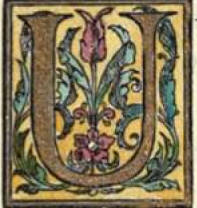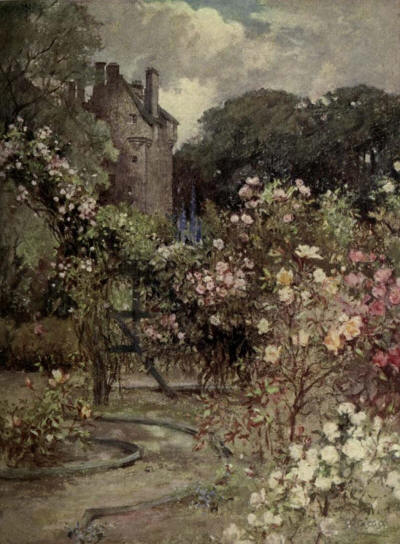|
 NDOUBTEDLY
there is more difficulty in fixing upon representative gardens from the
east of Scotland than from the west, arising, not from paucity of good
subjects, but from their greater frequency. Not that the horticulture of
the west is inferior to that of the east ; but, as a rule, families
resident in the eastern counties have shown more constancy for old
walls, and a more conservative sentiment in adapting old houses to
modern requirements, than those in the west have done. This was owing
partly to the better building material in Lothian, Fife and Aberdeen,
and partly to the superior affluence of those districts as compared with
the western shires previous to the development of mineral resources.
There are notable exceptions, of course, some of which, such as Kelburne
and Dalzell, have been assigned a place in this collection; but, on the
whole, domestic architecture in the west has suffered far more sweeping
changes than it has in the eastward counties. NDOUBTEDLY
there is more difficulty in fixing upon representative gardens from the
east of Scotland than from the west, arising, not from paucity of good
subjects, but from their greater frequency. Not that the horticulture of
the west is inferior to that of the east ; but, as a rule, families
resident in the eastern counties have shown more constancy for old
walls, and a more conservative sentiment in adapting old houses to
modern requirements, than those in the west have done. This was owing
partly to the better building material in Lothian, Fife and Aberdeen,
and partly to the superior affluence of those districts as compared with
the western shires previous to the development of mineral resources.
There are notable exceptions, of course, some of which, such as Kelburne
and Dalzell, have been assigned a place in this collection; but, on the
whole, domestic architecture in the west has suffered far more sweeping
changes than it has in the eastward counties.

In no place that I have
visited does the fleeting present, represented by dainty flowers, appear
more closely interwoven with an enduring past, embodied in venerable
building, than at Kellie Castle. Standing in the midst of that fertile
champaign known as the East Neuk o' Fife, this impressive fortalice—so
smiling on its sunward side—so grim and boding on its northern—presents
externally much the same aspect as it did before Scotland and England
became one realm. Its very environment speaks of a simpler, less
affluent age than ours. Here is no far-reaching park, ambitiously
planned to yield its lord the impression that the sun and stars circle
in the heavens for his sole behoof. Only a narrow belt of aged trees
girdles the modest "policies," with cultivated farm-land coming up to
the very garden wall, as you may see around many substantial chateaux in
France. Nor does the venerable grove contain any of those modern
conifers whereof the indiscriminate use has done so much to mar many a
pretty pleasure ground. One solitary larch seems almost to apologise for
its alien presence among lofty beech and ash trees, massive sycamores,
and wych elms.
Before explaining the
felicitous circumstance which has preserved the true character of this
fine old house, a few notes upon its past may enable the visitor to
appreciate the intelligent taste of its present occupants. Originally
the principal messuage of the family of Seward or Siward, it passed in
1360 to Sir Walter Oliphant of Gask, who married Elizabeth, natural
daughter of Robert the Bruce. The fifth Lord Oliphant, succeeding to the
great estates in 1593, so squandered his means by extravagant living
that his cousin Patrick, succeeding about 1613, sold the property to
Erskine Viscount Fenton, who became Earl of Kellie in 1619. He and his
descendants greatly impoverished themselves by their enthusiasm for the
Stuart cause, Alexander, the sixth Earl, being among the very few
persons of position who went "out" in the '45. An old tree in the garden
of Kellie is shown as his temporary hiding place at that time. He paid
the penalty of three years' imprisonment, and finally received a free
pardon. His son, the seventh Earl, who earned by his musical gifts the
sobriquet of "Fiddler Tam," sold his whole estate, except the castle,
and two or three hundred acres adjoining, to Sir John Anstruther. In
1875 the fourteenth Earl of Kellie was declared heir to the earldom of
Mar in the creation of 1565, and the two earldoms are now united in the
person of the twelfth Earl of Mar and fifteenth Earl of Kellie, who
rightly sets great store by the beautiful old house which he has
inherited, bereft though it be of all but a fragment of the broad lands
which once supported it.
By a stroke of rare good
fortune, both for the proprietor and all others interested in ancient
dwellings, the late Professor James Lorimer took a fancy to the place in
1878. Roofless, floorless, ruinous as was the castle, he obtained a long
lease of it and proceeded to reconstruct the fallen work, repair the
rest, and re-create the whole grounds and garden in the spirit of the
seventeenth century. Admirably did he succeed, and, although he has
passed away, his widow and his son, Mr. R. S. Lorimer, A.R.S.A., most
faithfully and tenderly carry on his plan and purpose, which is
explained and commemorated by an inscription graven over the entrance:

1 "This dwelling, having
been cleared of crows and owls, has been devoted to honourable repose
from labour." The legend was written by the late Principal Sir Alexander
Grant.
"To me, as an architect,"
writes Mr. R. S. Lorimer, "the interesting point about the house is that
the plan has not been interfered with or modernised, and the exterior of
the house is practically untouched. So many of the fine old Scotch
houses were ruined by Bryce and others fifty or sixty years ago, the old
portion being entirely surrounded by modern work; whereas, when it is
necessary to add to an old Scotch house, the old portion ought to be
allowed to stand up and tell its own story, and the new portion should
be joined on to it by some narrow neck so that there never can be any
question as to which is the old and which is the new.
"One of the
characteristics of Kellic is the fact that the walled garden enters
direct out of the house, and that the flowers, and fruit, and vegetables
are all mixed up together.
"I always think the ideal
plan is to have the park, with the sheep or beasts grazing in it, coming
right under the windows at one side of the house, and the gardens
attached to the house at another side. We could not quite manage this at
Kellie but put as light a fence as possible between the lawn and the
park."
The castle garth, with
its sunny grey walls, archway of clipped yew, trellised roses, and thick
box edging a couple of feet high, has been kept much as it must have
been when "Fiddler Tam" made it resound with the strains of his violin.
The charm of eld, so difficult of attainment by any accelerating
process, hallows every bush and border. Little is grown here except the
common old favourites of our great-grandmothers ; some fine plants of
Piptanthus nepalensis, flowering luxuriantly at the time of my visit,
seemed scarcely at home among their eighteenth century neighbours. A
modern garden house, with stone roof and shadowy eaves, at the
north-east corner of the garth, has been so deftly brought into harmony
with a distant past, as to cheat one into believing it to be part of the
original design.
And over all this
tranquil scene presides the time-worn fortalice, with its crow-stepped
gables and clustered tourelles, prompting the inevitable, invariable
wish—"Ah, could these walks but speak!" "Futile!" say you. Nay, but they
do speak, and have much to tell to understanding hearers.
"All pain, all passion,
all regret,
All love and longing come
To swell the strain whose burden yet
Imploreth `Home, sweet home.'" |
